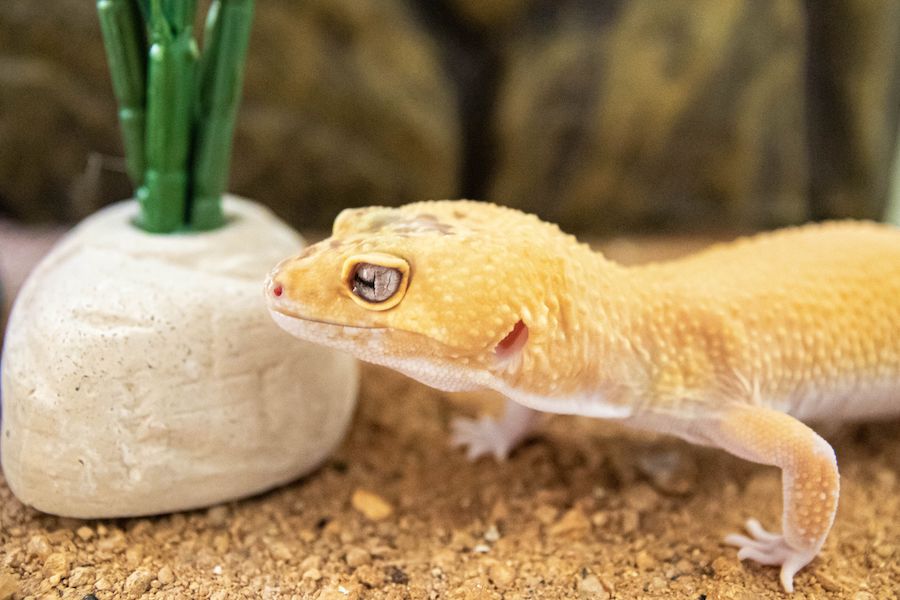The leopard gecko’s adorable grin attracts individuals of different ages and levels of experience in reptile care, making this splendid creature a popular choice for anyone interested in keeping a reptile. They are simple to tame, don’t take much time or money to care for, and are gentle by nature.Go further to know Leopard Gecko Care Sheet Guide.
In addition, Leopard Geckos, often known as Leos, are excellent pets for even more experienced lizard enthusiasts who are keen on breeding uncommon color morphs and patterning! They vary from other lizard species and those in their genus. Let’s check out the details of ‘Leopard Gecko Care Sheet’.
Table of Contents
The Lifespan Of The Leopard Gecko
The reptile is among the world’s longest-living. The average lifespan is six to 10 years. However, some males may survive for up to twenty.
Leopard Gecko Food
It is healthy knowledge that geckos are insectivorous lizards, and they prefer to consume live insects in the vast majority of situations. Fortunately, you can raise feeder insects at home, purchase them online, or pick them up at your local pet shop if you’re worried.
Last update on 2022-07-08 / Affiliate links / Images from Amazon Product Advertising API
Mealworms, crickets, emphasis on making, and red wigglers are among leopard gecko’s favourite foods. As previously said, all of these insects may be raised relatively quickly in your own house. A specific reptile vitamin/mineral supplement will need to be regularly applied to Leo’s diet. Their tanks must contain some pure calcium if they are to work correctly.
Leopard Gecko tank and cage
You’ll need at least a 20-gallon vivarium for one mature Leopard Gecko. A vivarium made of wood or glass is suitable. When it comes to lizards, this isn’t the case. Many people like to keep their Geckos in the same 20-gallon tank that they keep their adult Geckos. For breeding purposes, a 40-gallon tank is the best choice. If you’re keeping more than one lizard, ensure each has its hiding spot.
An adult gecko may fit comfortably inside one of the three separate hideouts provided in each cage. Moisture, warmth, or coolness are essential considerations when choosing a hiding place.
Last update on 2022-07-08 / Affiliate links / Images from Amazon Product Advertising API
Coconut fiber or peat moss may produce a micro-humidity chamber in some hideouts, which will aid in shedding. If leopard geckos have soaking bowls and micro-humidity chambers, they don’t need to be bathed.
Place the hideouts in the cage at varying heights so that the animals may access them both from the top and the bottom. The tank will look beautiful if you add non-toxic trousers and branches, and pebbles to the cage.
Leopard Gecko Ambient Light and Heat
Their tank necessitates using a midday basking lamp and a nighttime ceramic bulb. With one side at 90°F and the other at 75°F, they need a heat gradient. Because they love cool-white light, make sure their basking bulbs are not very bright.
For the safety of leopard geckos, the lights must be switched off 12 times at night. Temperatures at night may dip to around 70 degrees Fahrenheit, but they shouldn’t fall much lower.
Last update on 2022-07-08 / Affiliate links / Images from Amazon Product Advertising API
If your aquarium’s basking light isn’t enough to keep the water temperature stable, an under-tank heating element can be suitable. Because they live in a desert, humidity levels should be kept between 30 and 40 percent.
Leopard Gecko Care Guide Sheet – I hope you have got all the details.









![Zoomed Repti Basking Spot Bulb [Value 2 Pack 100 WATT] - Includes Attached DBDPet Pro-Tip Guide](https://m.media-amazon.com/images/I/51seID+UbtL.jpg)